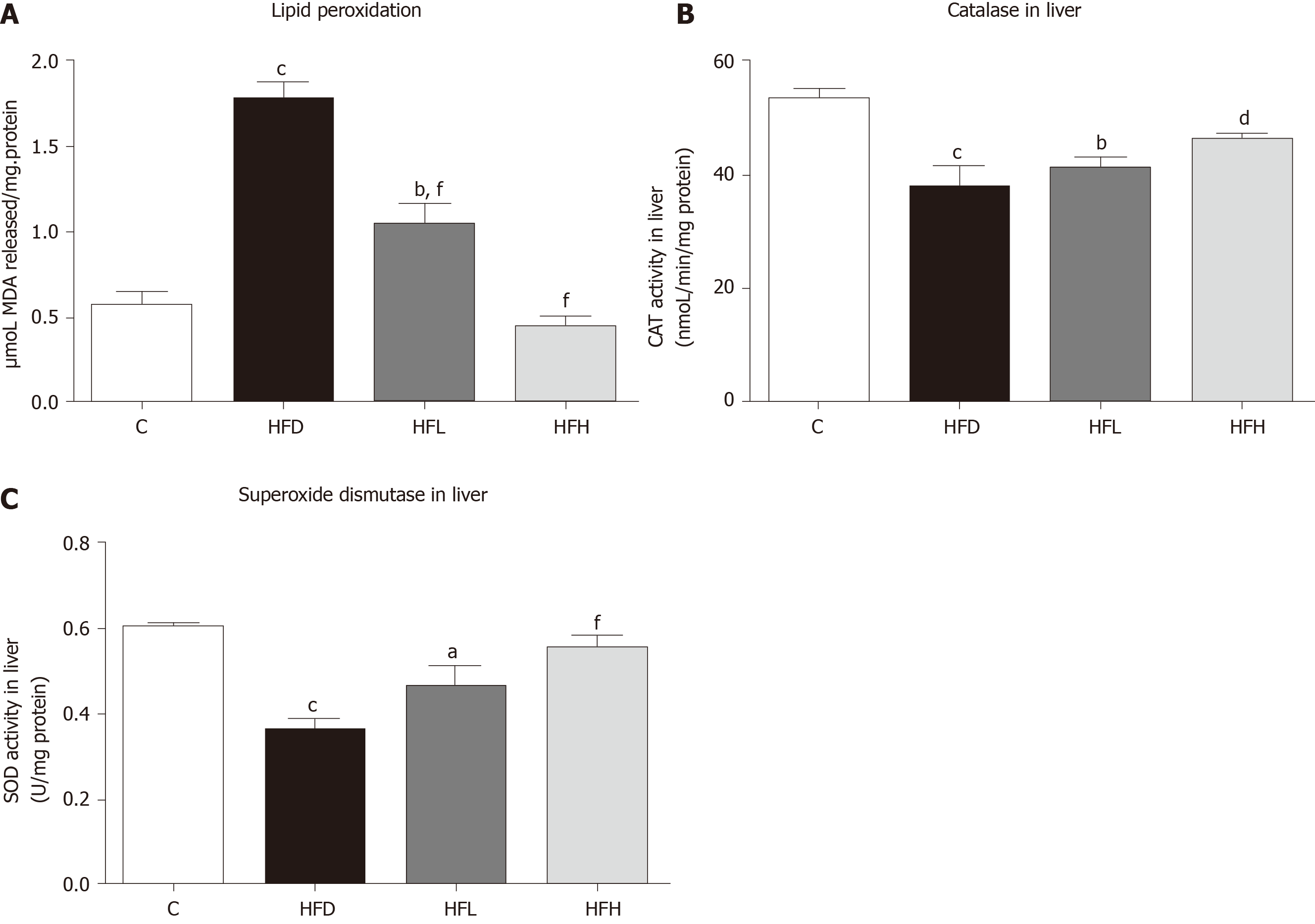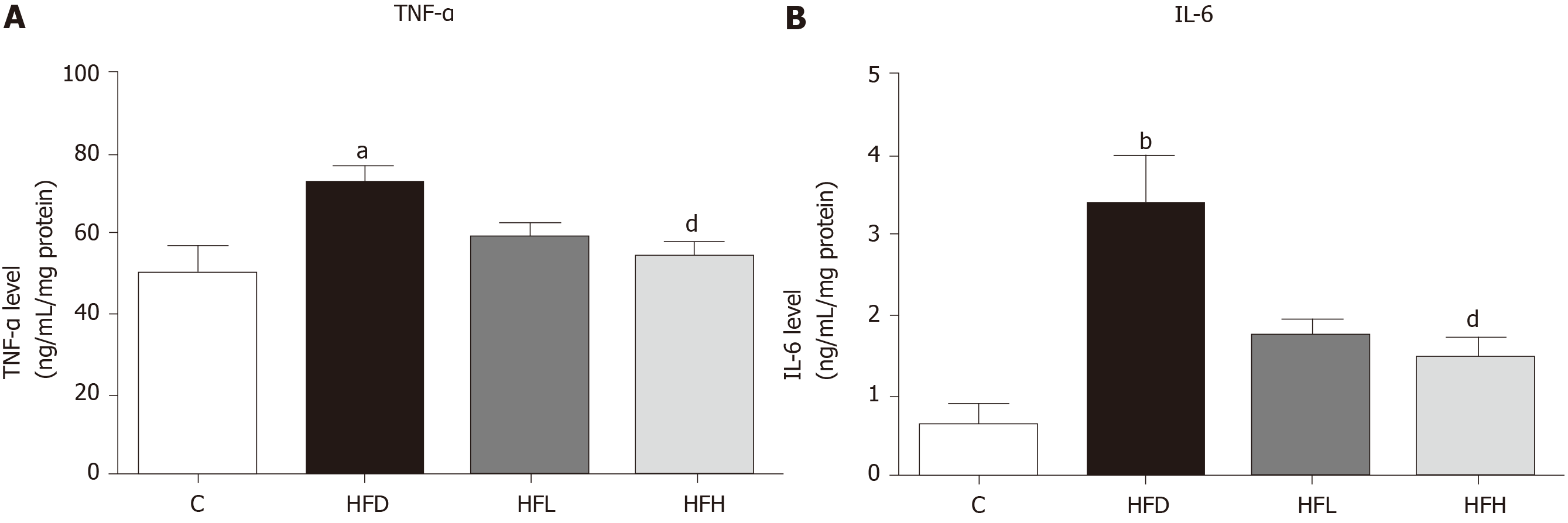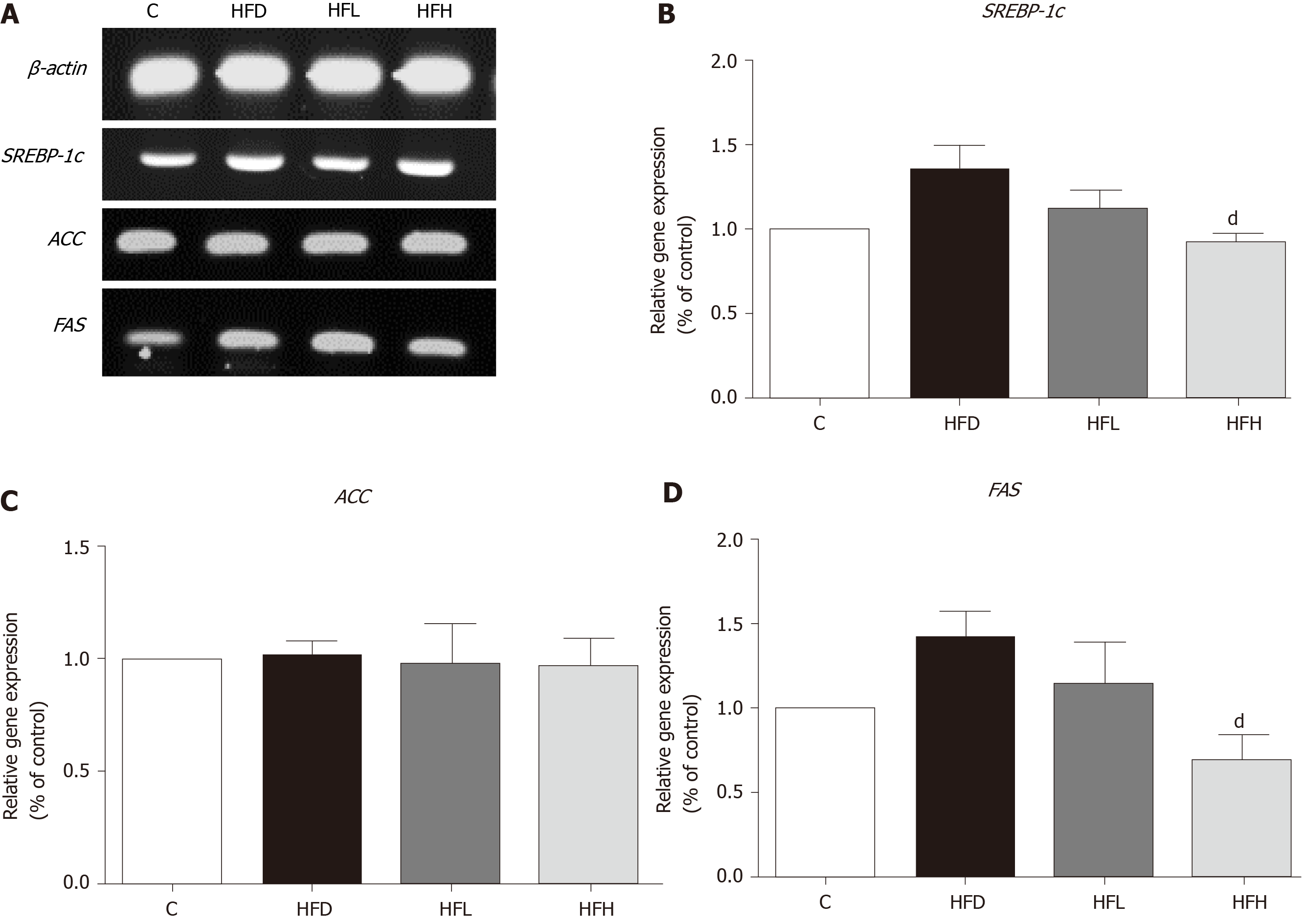Copyright
©The Author(s) 2021.
World J Hepatol. Mar 27, 2021; 13(3): 315-327
Published online Mar 27, 2021. doi: 10.4254/wjh.v13.i3.315
Published online Mar 27, 2021. doi: 10.4254/wjh.v13.i3.315
Figure 1 Effect of papaya on non-alcoholic fatty liver disease.
A: Macroscopic and microscopic appearance in rat hepatocytes. Macrovesicular steatosis (black arrow) are large lipid droplets that are present in the hepatocytes. Microvesicular steatosis (red arrow) are small lipid droplets that are present in the hepatocytes. Hepatocyte ballooning is recognised as cell swelling and enlargement within the cytoplasm (yellow arrow). Lobular inflammation in non-alcoholic steatohepatitis foci (dotted line arrow) are scattered in the hepatic lobule; B: Comparative analysis of non-alcoholic fatty liver disease activity score for all treatment groups. Data are expressed as mean ± SE of the mean (n = 6-7). aP < 0.05, bP < 0.01, cP < 0.001 vs C, and dP < 0.05 vs high fat diet group. C: Control; H&E: Hematoxylin and eosin; HFD: High fat diet; HFH: High fat diet treated with 1 mL of papaya juice/100 g body weight; HFL: High fat diet treated with 0.5 mL of papaya juice/100 g body weight; NAS: Non-alcoholic fatty liver disease activity score.
Figure 2 Effects of papaya on antioxidant activities in liver tissue.
A: Lipid peroxidation in the liver; B: Activity of catalase (CAT) in the liver; C: Activity of superoxide dismutase (SOD) in the liver. Data are expressed as mean ± SE of the mean (n = 6-7). aP < 0.05, bP < 0.01, cP < 0.001 vs control (C), and dP < 0.05, fP < 0.001 vs high fat diet (HFD) group. HFH: High fat diet treated with 1 mL of papaya juice/100 g body weight; HFL: High fat diet treated with 0.5 mL of papaya juice/100 g body weight; MDA: Malondialdehyde.
Figure 3 Effects of papaya on proinflammatory cytokines in liver tissue.
A: Tumour necrosis factor-α (TNF-α) in the liver; B: Interleukin 6 (IL-6) in the liver. Data are expressed as mean ± SE of the mean (n = 6-7). aP < 0.05, bP < 0.01 vs control (C), and dP < 0.05 vs high fat diet (HFD) group. HFH: High fat diet treated with 1 mL of papaya juice/100 g body weight; HFL: High fat diet treated with 0.5 mL of papaya juice/100 g body weight.
Figure 4 Effects of papaya on de novo lipogenic gene expression in liver tissue.
A: Immunoblotting analysis of SREBP-1c, ACC, FAS and ACTB. ACTB was used as a normalization gene; B: Relative gene expression of SREBP-1; C: Relative gene expression of ACC; D: Relative gene expression of FAS. Data are expressed as mean ± SE of the mean (n = 5). dP < 0.05 vs high fat diet (HFD) group. C: Control; HFH: High fat diet treated with 1 mL of papaya juice/100 g body weight; HFL: High fat diet treated with 0.5 mL of papaya juice/100 g body weight.
Figure 5 Schematic diagram of possible mechanism of papaya juice on non-alcoholic fatty liver disease.
The beneficial effect of papaya against hepatic steatosis in obese rats may occur through the inhibition of lipogenic pathways by reducing SREBP-1c and FAS gene expression, causing the reduction of hepatic fat accumulation. Papaya can improve enzymatic antioxidants [catalase (CAT) and superoxide dismutase (SOD)] and decrease lipid peroxidation in the liver. The administration of papaya significantly decreased proinflammatory cytokines such as tumour necrosis factor-α (TNF-α) and interleukin 6 (IL-6) to modulate liver damage. Papaya is therefore able to reduce the activities of aspartate transaminase (AST) and alanine transaminase (ALT) in serum. Overall, this study provides evidence for the beneficial effects of papaya to reverse the progression of non-alcoholic fatty liver disease in obese rats. ALP: Alkaline phosphatase; FFAs: Free fatty acids; HFD: High fat diet; ROS: Reactive oxygen species; TBARS: 2-Thiobarbituric acid reactive substances.
- Citation: Deenin W, Malakul W, Boonsong T, Phoungpetchara I, Tunsophon S. Papaya improves non-alcoholic fatty liver disease in obese rats by attenuating oxidative stress, inflammation and lipogenic gene expression. World J Hepatol 2021; 13(3): 315-327
- URL: https://www.wjgnet.com/1948-5182/full/v13/i3/315.htm
- DOI: https://dx.doi.org/10.4254/wjh.v13.i3.315













